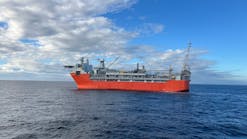Statoil lets contract for Norwegian Sea spar hull
Statoil SA has signed a letter of intent with Technip for the construction of the hull for the spar platform to be used for development of Aasta Hansteen gas and condensate field in the northern Norwegian Sea. The project will be led by Technip in a consortium with Hyundai Heavy Industries.
Statoil picked the spar design earlier this year (OGJ Online, Jan. 30, 2012). The field, formerly called Luva, lies in the Voring basin on production license 218/218B in 1,300 m of water.
Technip says the spar platform, with a total hull length of 195 m, will be the world’s largest and the first of its kind on the Norwegian continental shelf (NCS). The structure also will be the first spar with storage capacity and will be able to store about 25,000 standard cu m of condensate, and export gas via the Norwegian Sea Gas Infrastructure (NSGI) project.
“The hull contract is an important first construction step for the Aasta Hansteen field development,” said Ivar Aasheim, Statoil's senior vice-president for field development on the NCS. “Aasta Hansteen is the start of deepwater development in the Norwegian Sea and the development could also open up for tie-backs to other discoveries in the same area,” he said.
The spar platform will be built in South Korea and transported on the world's largest heavy-lift carrier. Technip will design, procure, and deliver the spar platform hull readied for mating with the platform topsides in Norway. The supplier also will design and prepare specifications for steel rigid risers and a complete mooring system.
The estimated contract value for this assignment is just over 4 billion kroner.
“We’ve had several early-phase and concept studies for the entire Aasta Hansteen project, with Technip, Aker, Samsung, FMC, Saipem, and IKM, among others, involved in developing the concept,” said Anders Opedal, senior vice-president for projects at Statoil.
By this fall and the following spring, Statoil said it will award contracts for topsides, subsea facilities, pipelines, marine operations, and drilling.
The Aasta Hansteen development lies 300 km offshore Norway and contains three gas discoveries. It was originally discovered in 1997. Statoil has been operating the filed since 2006.
Total reserves for Aasta Hansteen are estimated at 47 billion standard cu m of gas and 800 million cu m of condensate.
Partnership change
Separately, OMV signed an agreement to acquire 15% stake in Aasta Hansteen field from ExxonMobil Corp. The field’s partnership interest holders are operator Statoil 75%, OMV 15%, and ConocoPhillips 10%.
OMV also increased its stake in the NSGI project by 6.15%. Together with its share gained through an acquisition in December 2011, OMV holds a total of 7.9% in NSGI.
The scope of the NSGI project comprises a 480-km, 36-in. pipeline from Aasta Hansteen field to the Nyhamna gas processing plant and an expansion of the Nyhamma gas plant. The pipeline also will allow the connection of the Linorm and Zidane fields as well as possible tie-ins of other discoveries.
NSGI is operated by Statoil. Partners are OMV, Centrica, ConocoPhillips, Edison, E.On Ruhrgas, GDF Suez, Maersk, Petoro, RWE Dea, Shell, and Total.
Steven Poruban | Managing Editor-News
Steven Poruban was hired as staff writer for Oil & Gas Journal in October 1998. Two years later, he was promoted to senior staff writer. In October 2004, he was then promoted to senior editor. He now serves as managing editor-news.
Before working for OGJ, Steven was a reporter for Gas Daily and editor of Gas Transportation Report. He attended Boston University then transferred to and graduated from Ursinus College in Collegeville, Pa., with a BA in English in 1993.
